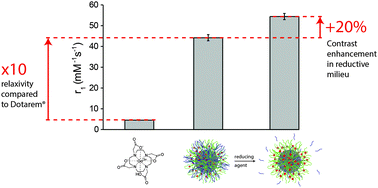Nanoparticle-based highly sensitive MRI contrast agents with enhanced relaxivity in reductive milieu†
Abstract
Current magnetic resonance imaging (MRI) contrast agents often produce insufficient contrast for diagnosis of early disease stages, and do not sense their biochemical environments. Herein, we report a highly sensitive nanoparticle-based MRI probe with r1 relaxivity up to 51.7 ± 1.2 mM−1 s−1 (3T). Nanoparticles were co-assembled from Gd3+ complexed to heparin–poly(dimethylsiloxane) copolymer, and a reduction-sensitive amphiphilic peptide serving to induce responsiveness to environmental changes. The release of the peptide components leads to a r1 relaxivity increase under reducing conditions and increases the MRI contrast. In addition, this MRI probe has several advantages, such as a low cellular uptake, no apparent cellular toxicity (tested up to 1 mM Gd3+), absence of an anticoagulation property, and a high shelf stability (no increase in free Gd3+ over 7 months). Thus, this highly sensitive T1 MRI contrast nanoparticle system represents a promising probe for early diagnosis through possible accumulation and contrast enhancement within reductive extracellular tumour tissue.


 Please wait while we load your content...
Please wait while we load your content...